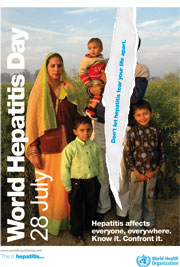 Last week was an eventful week for this HBV blogger. I was fortunate to be able to attend the National Viral Hepatitis Technical Assistance and the National Viral Hepatitis Round Table (NVHR) meetings in Washington D.C. last Tuesday and Wednesday. These meetings were followed by Capitol Hill visits on Thursday by viral hepatitis advocates to their legislative offices.
Last week was an eventful week for this HBV blogger. I was fortunate to be able to attend the National Viral Hepatitis Technical Assistance and the National Viral Hepatitis Round Table (NVHR) meetings in Washington D.C. last Tuesday and Wednesday. These meetings were followed by Capitol Hill visits on Thursday by viral hepatitis advocates to their legislative offices.
In attendance at the meeting were state viral hepatitis coordinators from around the country, other state health department personnel, government representatives from various agencies and organizations, and numerous viral hepatitis advocates from various non-profit organizations. It was a great opportunity to meet colleagues from all over the country dedicated to combating viral hepatitis in the United States.
Please keep in mind that my background is patient oriented, and that I do not have a master’s degree in public health, nor do I have experience working in the public health system. Keeping up with the political front is challenging as is keeping up with the public health system. I’m still trying to figure it all out. Both have their own language and acronyms. After a couple of days of meetings, I have a great deal of respect for those working in public health at both the federal and state level. I also have a great deal of respect for those working to push policy on behalf of viral hepatitis. There’s always more to learn, but you can still make an impact by jumping in and getting involved at a number of different levels.
A couple of messages were loud and clear at the meeting and you didn’t need to be an expert to understand them. Perhaps the biggest message is that funding for viral hepatitis public health programs is very limited and the burden is well beyond the level of funding. This comes as no surprise since these are difficult times for both state and federal government programs. This lack of funding will require that all health departments, government organizations and agencies, advocacy groups and non-profits pull together using what I call the 3-C’s: communication, coordination, and collaboration. Don’t forget to be creative, resourceful and wrap it all up with a coordinated IT system.
What was nice about this forum is that people were able to see what was going on in other states. Bringing people together infuses new information into the group, while creating relationships where people want to help one another. This is imperative if we are to address viral hepatitis needs with a minimal budget. One viral hepatitis coordinator reminded people during a break-out session that there are small pots-of-money out there, but you’re going to have to be creative when looking for grant opportunities.
Chris Taylor from the National Alliance of State & Territorial Aids Directors (NASTAD) asked me, and others to do a video-taped interview where I was asked about my personal hepatitis B story. This was a great way for me to make a contribution, and I was happy to help. Telling your story can be a compelling way to raise awareness and get involved.
Natalie Cole was in D.C. doing a press conference promoting her “Tune In to Hep C” campaign. NASTAD arranged for her to make an appearance at the NVHR meeting. It’s always great to have a celebrity figure to promote a cause and raise awareness with the general public. They are able to reach so many people at one time!
Thursday’s Capitol Hill visits were a great opportunity for viral hepatitis advocates to get in front of their own Representatives in Congress, or their state Senators. Each person on the visit brought her talents to the table. Some were up on politics, policy and the process, while others dealt with the hepatitis at the public health level. Finally, there are people like me that are most familiar with hepatitis B on a personal level.
The meetings made it clear that we all need to collaborate and be creative if we are going to combat viral hepatitis. Americans living with viral hepatitis may be wondering what Washington or their home-state is doing about viral hepatitis. Things are being accomplished. Based on the Institute of Medicine (IOM) report, we have the HHS Action Plan for the Prevention, Care & Treatment of Viral Hepatitis that was introduced last May. Planning and process is currently being written around the plan. People are in place and they are working hard, but the system and its processes are huge, complicated, and slow moving. It is certainly not a perfect system, but we can all contribute at some level to make this an issue important to those that do drive policy, and ultimately fund programs.
Where do you fit in? If you are in policy or public health you know you have a big job ahead of you, but it is essential that you keep looking for ways to move the system more effectively and efficiently. If you’re living with HBV, you might think you can’t make a contribution, but that is not true. This is where “arm-chair advocacy” comes in. Not everyone is going to head to D.C. to meet with their Senator or Congress person. However, you can make your voice heard. Visit your representative when she is home for constituent work week. A simpler, but equally effective alternative is to write, call, email or tweet your Representative or Senator. Let your Representative know that you are living with hepatitis B, and that you want him to support viral hepatitis legislation. Use your voice and make your vote work for those living with HBV in your state!








